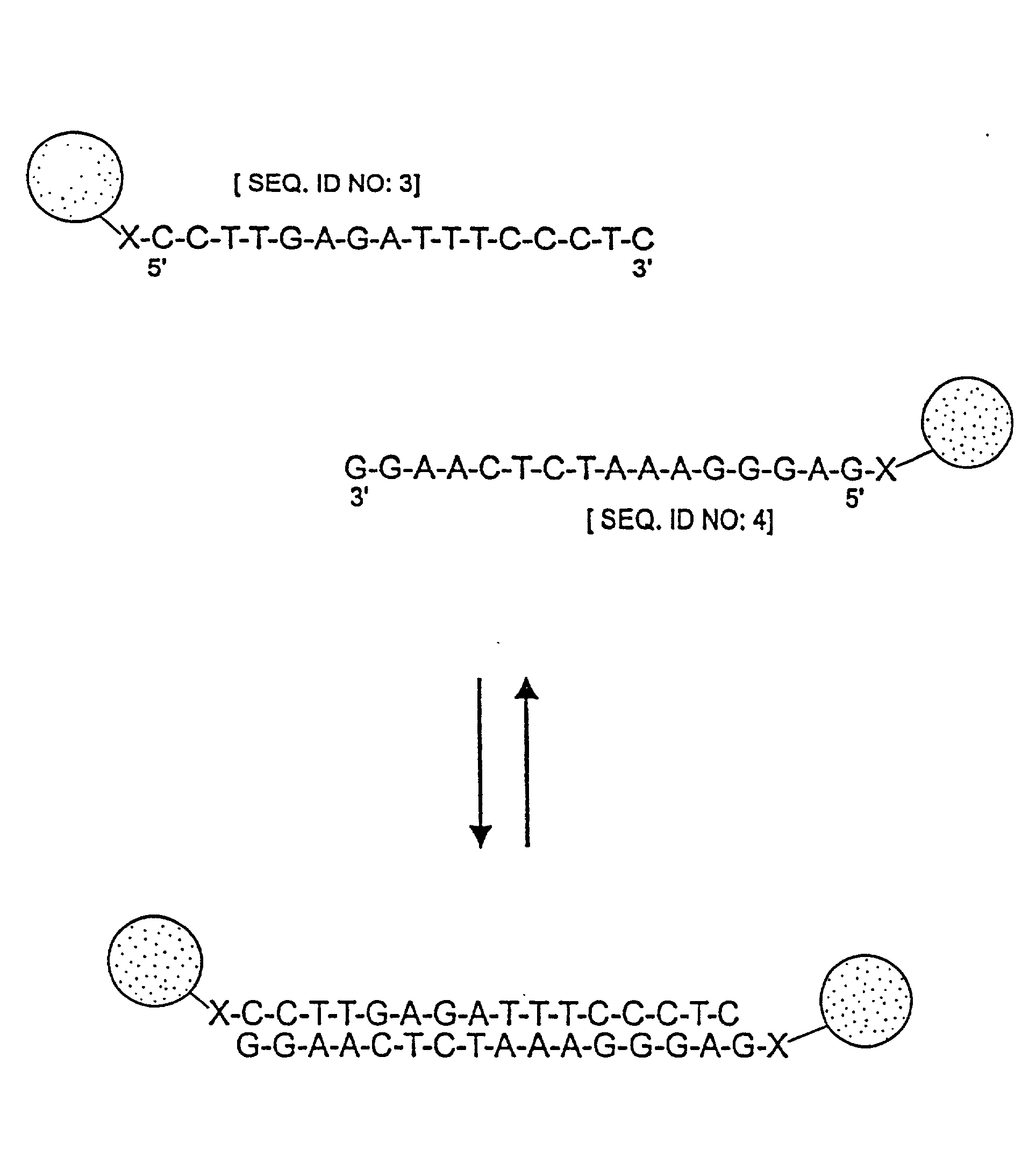Nanoparticles having oligonucleotides attached thereto and uses therefor
a technology of oligonucleotides and nanoparticles, which is applied in the field of nanoparticles having oligonucleotides attached thereto and uses therefor, can solve the problems of complex methods, time-consuming and/or expensive equipment, and assembly formation irreversibly,
- Summary
- Abstract
- Description
- Claims
- Application Information
AI Technical Summary
Benefits of technology
Problems solved by technology
Method used
Image
Examples
second embodiment
[0214] In a second embodiment, the kit comprises at least two containers. The first container holds nanoparticles having oligonucleotides attached thereto which have a sequence complementary to the sequence of a first portion of a nucleic acid. The second container holds nanoparticles having oligonucleotides attached thereto which have a sequence complementary to the sequence of a second portion of the nucleic acid. The kit may further comprise a third container holding a filler oligonucleotide having a sequence complementary to a third portion of the nucleic acid, the third portion being located between the first and second portions.
[0215] In another alternative embodiment, the kits can have the oligonucleotides and nanoparticles in separate containers, and the oligonucleotides would have to be attached to the nanoparticles prior to performing an assay to detect a nucleic acid. The oligonucleotides and / or the nanoparticles may be functionalized so that the oligonucleotides can be a...
example 1
Preparation of Oligonucleotide-Modified Gold Nanoparticles
A. Preparation of Gold Nanoparticles
[0268] Gold colloids (13 nm diameter) were prepared by reduction of HAuCl.sub.4 with citrate as described in Frens, Nature Phys. Sci., 241, 20 (1973) and Grabar, Anal. Chem., 67, 735 (1995). Briefly, all glassware was cleaned in aqua regia (3 parts HCl, 1 part HNO.sub.3), rinsed with Nanopure H.sub.2O, then oven dried prior to use. HAuCl.sub.4 and sodium citrate were purchased from Aldrich Chemical Company. Aqueous HAuCl.sub.4 (1 mM, 500 mL) was brought to reflux while stirring. Then, 38.8 mM sodium citrate (50 mL) was added quickly. The solution color changed from pale yellow to burgundy, and refluxing was continued for 15 min. After cooling to room temperature, the red solution was filtered through a Micron Separations Inc. 1 micron filter. Au colloids were characterized by UV-vis spectroscopy using a Hewlett Packard 8452A diode array spectrophotometer and by Transmission Electron Microsc...
example 2
Formation of Nanoparticle Aggreates
A. Preparation of Linking Oligonucleotide
[0277] Two (nonthiolated) oligonucleotides were synthesized as described in part B of Example 1. They had the following sequences:
[0278] 3' ATATGCGCGA TCTCAGCAAA [SEQ ID NO:1]; and
[0279] 3' GATCGCGCAT ATCAACGGTA [SEQ ID NO:2].
[0280] Mixing of these two oligonucleotides in a 1 M NaCl, 10 mM phosphate buffered (pH 7.0) solution, resulted in hybridization to form a duplex having a 12-base-pair overlap and two 8-base-pair sticky ends. Each of the sticky ends had a sequence which was complementary to that of one of the oligonucleotides attached to the Au colloids prepared in part C of Example 1.
B. Formation of Nanoparticle Aggregates
[0281] The linking oligonucleotides prepared in part A of this example (0.17 .mu.M final concentration after dilution with NaCl) were added to the nanoparticle-oligonucleotide conjugates prepared in part C of Example 1 (5.1 nM final concentration after dilution with NaCl) at room temp...
PUM
| Property | Measurement | Unit |
|---|---|---|
| Tm | aaaaa | aaaaa |
| temperature | aaaaa | aaaaa |
| pH | aaaaa | aaaaa |
Abstract
Description
Claims
Application Information
 Login to View More
Login to View More - R&D
- Intellectual Property
- Life Sciences
- Materials
- Tech Scout
- Unparalleled Data Quality
- Higher Quality Content
- 60% Fewer Hallucinations
Browse by: Latest US Patents, China's latest patents, Technical Efficacy Thesaurus, Application Domain, Technology Topic, Popular Technical Reports.
© 2025 PatSnap. All rights reserved.Legal|Privacy policy|Modern Slavery Act Transparency Statement|Sitemap|About US| Contact US: help@patsnap.com



